Global Discoveries on DVD: A (Mainly) Alphabetical Listing of 24 Items
By Jonathan Rosenbaum
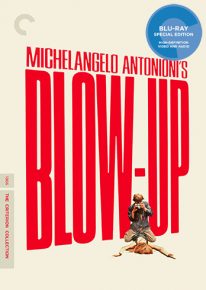
Blow-Up (Criterion Blu-ray). I’ve always had somewhat mixed feelings about Michelangelo Antonioni’s 1967 Swinging London hit: awe and admiration for his uncanny handling of space, colour, mood, and non-narrative stasis in juxtaposition with his metaphysical detective story, and irritation about the show-offy, fashion-plate ambience that seemed far more responsible for the movie’s commercial success than the more subtle signs of its director’s artistry. Maybe Dwight Macdonald was right in praising much of the fashionable material as satire (although I can’t believe that this applies to any of the epilogue with the mimes), but what I found both pretentious and irritating about it all was the degree to which attitude, ugly flourishes of power and privilege, and S&M teases deriving from both were at the hub of the movie’s ambivalent treatment of the milieu. (Clearly, similar doses of caustic and casual cruelty and petty power games were behind the success of Mike Nichols’ film of Who’s Afraid of Virginia Woolf?, which came out the year before. Where Blow-Up differs is in the degree of discontinuity that the photographer hero brings to his daily routines, appointments, and commitments, an itinerary that registers as a string of interruptions motored by glib diffidence.)
Criterion’s Blu-ray of Blow-Up does a good job of feeding my ambivalence, although it’s worth adding that in a few pithy comments recorded in the mid-’60s, David Hemmings offers a far more intelligent critique of his lead character (and, by extension, the film’s trendiness) than Vanessa Redgrave does in a much lengthier interview given more recently, in which her focus is almost entirely on Antonioni’s formal gifts. However one slices it, this release offers a lot of helpful supplements, including the Julio Cortázar story that inspired the film and some suggestive remarks about art history by David Alan Mellor.
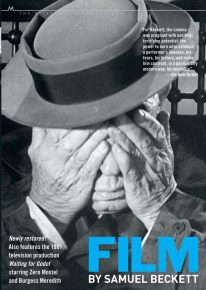 Film and Notfilm (separate Milestone Blu-rays). Part of the wisdom of Milestone making separate releases out of Samuel Beckett’s disappointing but fascinating 22-minute Film (1964, starring Buster Keaton and directed by Alan Schneider) and Ross Lipman’s brilliant and informative recent 130-minute essay film about it, Notfilm (2015), is the wealth of extras made possible by this strategy. With the dialogue-less Film (one disc), you get Schneider’s entire 1961 TV production of Waiting for Godot with Zero Mostel and Burgess Meredith and the “dog and cat takes” (read “outtakes,” featuring Keaton’s double takes) from Film; with Notfilm (two discs) are eight separate aural and/or visual documentary supplements, including a seven-minute conversation between Beckett, Schneider, cinematographer Boris Kaufman, and others, and Mihály Vig’s entire score for Notfilm. (Incidentally, Notfilm includes captions in English and subtitles in French, German, Portuguese, and Spanish, whereas Waiting for Godot comes without any captions or subtitles.)
Film and Notfilm (separate Milestone Blu-rays). Part of the wisdom of Milestone making separate releases out of Samuel Beckett’s disappointing but fascinating 22-minute Film (1964, starring Buster Keaton and directed by Alan Schneider) and Ross Lipman’s brilliant and informative recent 130-minute essay film about it, Notfilm (2015), is the wealth of extras made possible by this strategy. With the dialogue-less Film (one disc), you get Schneider’s entire 1961 TV production of Waiting for Godot with Zero Mostel and Burgess Meredith and the “dog and cat takes” (read “outtakes,” featuring Keaton’s double takes) from Film; with Notfilm (two discs) are eight separate aural and/or visual documentary supplements, including a seven-minute conversation between Beckett, Schneider, cinematographer Boris Kaufman, and others, and Mihály Vig’s entire score for Notfilm. (Incidentally, Notfilm includes captions in English and subtitles in French, German, Portuguese, and Spanish, whereas Waiting for Godot comes without any captions or subtitles.)
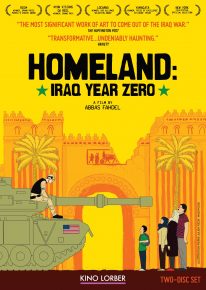 Homeland: Iraq Year Zero (Kino Lorber DVD). It was last year that Argentine critic and programmer Roger Alan Koza first alerted me to Abbas Fahdel’s amazing and indispensable epic, a two-part, five-and-a-half-hour documentary about the lives (and deaths) of Fahdel’s family and friends in Baghdad just before (February 2002) and after (2003) the American invasion. But I’ve been waiting for this release to see it all properly, on Kino Lorber’s excellent two-disc edition, which also includes Fahdel’s Q&A at the New York Film Festival. Even though the second part, “After the Battle,” is a quarter of an hour longer than the first part, “Before the Fall,” it’s the first section that I find the most valuable and memorable—and it’s made all the more devastating by our knowledge that Fahdel’s 12-year-old nephew Haidar, whom we see a great deal of, died during the shooting. The fact that we see the family in the opening sequence watching both a Foghorn Leghorn cartoon and Saddam Hussein on TV only begins to indicate how much this chronicle has to teach us about everyday life just before the so-called “war” (read: military occupation), in contrast to the glaring and wilful omissions in our news media.
Homeland: Iraq Year Zero (Kino Lorber DVD). It was last year that Argentine critic and programmer Roger Alan Koza first alerted me to Abbas Fahdel’s amazing and indispensable epic, a two-part, five-and-a-half-hour documentary about the lives (and deaths) of Fahdel’s family and friends in Baghdad just before (February 2002) and after (2003) the American invasion. But I’ve been waiting for this release to see it all properly, on Kino Lorber’s excellent two-disc edition, which also includes Fahdel’s Q&A at the New York Film Festival. Even though the second part, “After the Battle,” is a quarter of an hour longer than the first part, “Before the Fall,” it’s the first section that I find the most valuable and memorable—and it’s made all the more devastating by our knowledge that Fahdel’s 12-year-old nephew Haidar, whom we see a great deal of, died during the shooting. The fact that we see the family in the opening sequence watching both a Foghorn Leghorn cartoon and Saddam Hussein on TV only begins to indicate how much this chronicle has to teach us about everyday life just before the so-called “war” (read: military occupation), in contrast to the glaring and wilful omissions in our news media.
Impardonnables (UGC, PAL DVD) and The Witnesses/Les témoins (Artificial Eye, PAL DVD). Although I usually restrict myself in this column to releases that are either in English or have English subtitles, I’m making an exception for the DVD of Impardonnables, André Téchiné’s superb 2011 feature based on a novel by Philippe Djian and set in Venice—which has only sous-titres français pour sourds et malentendants—because you can’t see this film digitally any other way, and you should see it if you have at least a reading knowledge of French. Like my other favourite Téchiné features—Ma saison préférée (1993), Les roseaux sauvages (1994), Les voleurs (1996), and Les témoins (2007), which I’ve just seen for the first time—this has a kind of novelistic density that’s rare in contemporary French cinema, and is populated by lovable, neurotic eccentrics (in this instance, Carole Bouquet as a real estate agent, André Dussollier as a novelist and Adriani Asti as a lesbian detective, among others). In Les témoins (which is also available with English subtitles in North America, from Strand Releasing), set in France during the ’80s AIDS crisis, the lovable eccentrics include another novelist who’s a reluctant mother (Emmanuelle Béart); her bisexual husband, a French-Arab vice cop (Sami Bouajila); his young lover (Johan Libérau); and a gay middle-aged doctor (Michel Blanc). It’s hard to think of many writer-directors who can populate their features with so many vivid characters, and it’s worth adding that each feature here has an especially impressive character and performance: Asti’s in Impardonnables and Blanc’s in Les témoins.
 The Incredible Journey (Disney) and Jigsaw (Alpha Video). One of the mixed blessings of auteurism is the illusion of clarity. I call it “illusion” because most lives, careers, and artistic identities are messy and contradictory, not neat and clear the way that auteurism would have us think. All of which seems relevant to the identity of, say, Fletcher Markle (1921–1991), a Canadian actor, writer, director, and producer whom I briefly became acquainted with on the phone and as a charming pen pal in the late ’80s, in relation to my Orson Welles research. It was Markle who first contacted me, via Richard Wilson, although I can no longer remember precisely why. (It had something to do with his memoirs, which he regrettably never finished or published.) As a Canadian radio actor and director, Markle lampooned Welles on a 1946 show called Life with Adam that Welles presented on his own Mercury Summer Theater a week later; on the same show, Markle met Mercedes McCambridge, whom he eventually married, and remained a good friend of Welles for many years, serving as one of the uncredited writers on The Lady from Shanghai (1947) and the only one I know who’d ever seen Welles’ second TV pilot, Camille, The Naked Lady and the Musketeers (1956), made with the $5,000 fee Welles received for appearing on I Love Lucy and apparently destroyed or at least discarded by Welles after he couldn’t find a buyer for it.
The Incredible Journey (Disney) and Jigsaw (Alpha Video). One of the mixed blessings of auteurism is the illusion of clarity. I call it “illusion” because most lives, careers, and artistic identities are messy and contradictory, not neat and clear the way that auteurism would have us think. All of which seems relevant to the identity of, say, Fletcher Markle (1921–1991), a Canadian actor, writer, director, and producer whom I briefly became acquainted with on the phone and as a charming pen pal in the late ’80s, in relation to my Orson Welles research. It was Markle who first contacted me, via Richard Wilson, although I can no longer remember precisely why. (It had something to do with his memoirs, which he regrettably never finished or published.) As a Canadian radio actor and director, Markle lampooned Welles on a 1946 show called Life with Adam that Welles presented on his own Mercury Summer Theater a week later; on the same show, Markle met Mercedes McCambridge, whom he eventually married, and remained a good friend of Welles for many years, serving as one of the uncredited writers on The Lady from Shanghai (1947) and the only one I know who’d ever seen Welles’ second TV pilot, Camille, The Naked Lady and the Musketeers (1956), made with the $5,000 fee Welles received for appearing on I Love Lucy and apparently destroyed or at least discarded by Welles after he couldn’t find a buyer for it.
Working mostly as a producer and director for American television, Markle also directed two features for MGM: a bargain-basement noir called Jigsaw (1949) for an independent company, and a first-rate children’s feature (starring two dogs and a cat) shot in Canada for Disney, The Incredible Journey (1963). The latter of these, a remarkable tour de force from a technical standpoint as well as a lovely outdoors adventure, is the sort of worthy picture that remains off the charts when it comes to most cinephiliac and auteurist discourse, but I’m really glad that I saw it, something that never would have happened if it hadn’t been for my curiosity about Markle. Among other things, it brings back some of my childhood innocence in not having even a clue about how the struggles between these household pets and a bear could have possibly been filmed.
But when it comes to a lemon like Jigsaw, which Markle also co-wrote, I’m simply stumped. Even after conceding that the public-domain condition of the copy on Alpha Video probably makes it look worse than it actually is, and registering my disappointment that the political trappings of the mystery plot (which involves a right-wing hate group) remain unexplored, I’m forced to conclude that the only notable thing about this film is the number of gratuitous celebrity cameos it boasts: walk-ons by Burgess Meredith, Henry Fonda, Marsha Hunt, Everett Sloane, and John Garfield, among others (or, in the case of Marlene Dietrich, a walk-off—and she sure looks like she’s in a hurry). In the final analysis, I don’t know enough about the production circumstances of either Markle film to know whether he deserves credit or blame for either.
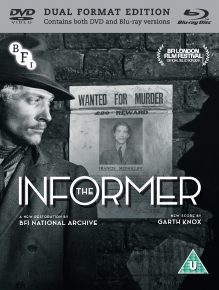 The Informer (BFI Blu-ray). When I requested a review copy of this, I wrongly assumed that this was a restored version of the John Ford chestnut of 1935, arguably overpraised at the time and (again arguably) underpraised more recently. In fact, this is a 1929 British adaptation of the same 1925 source novel by Liam O’Flaherty, “bringing together,” as Bryony Dixon puts it, “a German-American director [Arthur Robison], a German cinematographer, a Hungarian leading lady and a Swedish leading man with [a] British ensemble cast.” The film was shot in silent and sound versions; both are included, along with many extras.
The Informer (BFI Blu-ray). When I requested a review copy of this, I wrongly assumed that this was a restored version of the John Ford chestnut of 1935, arguably overpraised at the time and (again arguably) underpraised more recently. In fact, this is a 1929 British adaptation of the same 1925 source novel by Liam O’Flaherty, “bringing together,” as Bryony Dixon puts it, “a German-American director [Arthur Robison], a German cinematographer, a Hungarian leading lady and a Swedish leading man with [a] British ensemble cast.” The film was shot in silent and sound versions; both are included, along with many extras.
Invisible Ghost (Kino Lorber Blu-ray). Joseph H. Lewis directed this hokey but reasonably effective Sam Katzman/Bela Lugosi horror quickie for Monogram Pictures in 1941. I enjoyed most of it on its own terms before starting to listen to the audio commentary by Tom Weaver and a couple of his friends, which informed me right off the bat that I was supposed to take it all as camp. This was a disappointing sign of what I interpret as a generational difference between a tribe of cinephiles who prefer good movies and another, younger tribe which, in the name of democracy, prefers bad movies insofar as they allegedly turn us all into equals. (I hope I will be forgiven for suggesting that it’s the latter tribe that helped get Donald Trump elected.)
Kaili Blues (CNC). I haven’t yet seen Bi Gan’s 2015 Chinese feature—which made it onto several ten-best lists last year and acquired a ringing endorsement from the late Jonathan Demme—but by the time this reaches print, you’ll be able to purchase it on a Grasshopper DVD or Blu-ray. I picked up a French-subtitled version in Paris, which also includes a 14-minute interview with Bi Gan as well as an hour-long documentary about recent Chinese cinema made by Serge Le Péron for Cinéma, de notre temps; the Grasshopper release includes Bi Gan’s 2012 short Diamond Sutra.
Knight of Cups (Broadgreen Pictures Blu-ray). My enjoyment of Terrence Malick’s Song to Song (for some of its visuals and much of its editing) persuaded me to catch up with this earlier companion piece, but I couldn’t make it all the way through: too much humourless mental anguish combined with too much conspicuous consumption makes this a puritanical orgy whose excesses quickly become, shall we say, excessive, without being provocative (as are many of the excesses in ORG; see below).
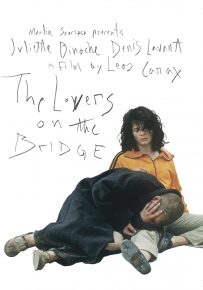 The Lovers on the Bridge (Kino Lorber Blu-ray) and Holy Motors (Vivendi Entertainment Blu-ray). The appearance of my two favourite Leos Carax films (along with Merde, his episode in the 2008 Tokyo!, another favourite which I don’t have) is cause for celebration. Even though I still can’t adjust to the English title of the 1991 Les amants du Pont-Neuf (having lived for five years only a couple of blocks away from this Parisian landmark), I can report that this release boasts an essay by Ignatiy Vishnevetsky and a video piece from MUBI by Cristina Álvarez López and Adrian Martin called “Water and Stone.” Included with Holy Motors (2012) is an engaging “making-of” documentary and an interview with Kylie Minogue.
The Lovers on the Bridge (Kino Lorber Blu-ray) and Holy Motors (Vivendi Entertainment Blu-ray). The appearance of my two favourite Leos Carax films (along with Merde, his episode in the 2008 Tokyo!, another favourite which I don’t have) is cause for celebration. Even though I still can’t adjust to the English title of the 1991 Les amants du Pont-Neuf (having lived for five years only a couple of blocks away from this Parisian landmark), I can report that this release boasts an essay by Ignatiy Vishnevetsky and a video piece from MUBI by Cristina Álvarez López and Adrian Martin called “Water and Stone.” Included with Holy Motors (2012) is an engaging “making-of” documentary and an interview with Kylie Minogue.
Ludwig (Arrow Films dual-format box set). The last (and only) time I saw Luchino Visconti’s two-part, four-hour epic about the mad king of Bavaria was in a Paris cinema in 1973, the year of its release; I’ve never seen its five-part television version, which is 21 minutes longer. This well-appointed box offers us both, along with a lovely 58-page booklet including a new essay by Peter Cowie, a 1986 interview with screenwriter Suso Cecchi D’Amico by Peter Brunette, and snippets from contemporary American and English reviews.
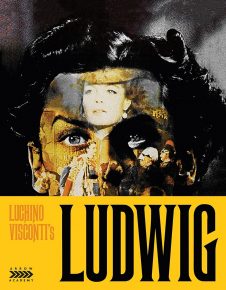 A three-hour version with English dialogue showed in the US in 1973 and then five years later in the UK, and the two versions here include all that dialogue, reverting to Italian for all the rest (apart from some bits of English narration that no longer fit, which are preserved as extras). Other extras—an impressive list, which is characteristic for Arrow—include new interviews with star Helmut Berger and producer Dieter Geissler, and separate documentaries about Visconti (by Carlo Lizzani), Suso Cecchi d’Amico, and actress Silvana Mangano.
A three-hour version with English dialogue showed in the US in 1973 and then five years later in the UK, and the two versions here include all that dialogue, reverting to Italian for all the rest (apart from some bits of English narration that no longer fit, which are preserved as extras). Other extras—an impressive list, which is characteristic for Arrow—include new interviews with star Helmut Berger and producer Dieter Geissler, and separate documentaries about Visconti (by Carlo Lizzani), Suso Cecchi d’Amico, and actress Silvana Mangano.
American Masters: Mike Nichols (American Masters DVD). Elaine May’s 54-minute documentary portrait (2016) of her former partner (which Sean Rogers wrote about in Cinema Scope 66) follows all the usual format rules of American Masters but also manages to impart a lot of intelligent and useful commentary along the way. For one thing, it persuaded me to belatedly catch up with a couple of Nichols films that I’d previously ignored: his 2003 TV miniseries Angels Over America (surely the high point of his career as a film director) and, to a lesser extent, Charlie Wilson’s War (2007).

ORG (Arsenal DVD). I blush to admit that I had no idea who Fernando Birri was until Volker Pantenburg contacted me about taking a look at Birri’s recently restored and seldom seen three-hour experimental opus ORG, aptly described on its own box as “monstrous” and by Birri himself as “absolutely demential.” An Argentine filmmaker, theorist, and teacher who studied film in Italy and is currently in his 90s, Birri premiered ORG (which is dedicated to Georges Méliès, Wilhelm Reich, and Che Guevara) at the Venice Film Festival in 1979 after spending over a decade making it; it was partly financed by Italian actor Terence Hill and contains over 26,000 cuts and around 70 audio tracks. Since this film (and Birri himself) is a continent I’ve only just discovered, let me conclude by noting that you can order ORG from German Amazon and learn more about Birri from an interview here.
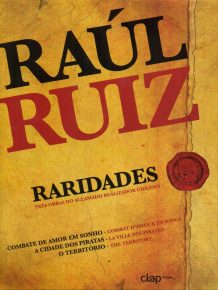 Raúl Ruiz: Raridades (Clap Filmes). I picked up this wonderful trilingual (French, English, Portuguese) three-disc DVD set including four Ruiz features—The Territory (1981), City of Pirates (1983), Vanishing Point (1984), and Combat d’amour en songe (2000)—at the Lisbon Cinematheque’s bookstore last year. It sells for only 15 euros plus postage from Portuguese FNAC, although if you want to order it from American Amazon as Raoul Ruiz Collection: (Rarities), it will cost you $56 plus postage (possibly as punishment for not trusting any languages except for English). I can also tell you that the bonus interview with Ruiz about City of Pirates offers the best account that I know of this mad project’s Surrealist origins. I can’t tell you why The Territory’s credits doesn’t include a screenwriter, but I suspect this is because Gilbert Adair removed his name, and I suspect Adair removed his name because he wasn’t happy with the way the film turned out. I do recall Ruiz telling me that he hoped to make up for this in his subsequent collaboration with Adair on A Closed Book aka Blind Revenge (2010), an adaptation of Adair’s novel, although I gather this ran into certain production difficulties as well—even though I still think it’s a better film than The Territory (or Vanishing Point) and deserves to be better known.
Raúl Ruiz: Raridades (Clap Filmes). I picked up this wonderful trilingual (French, English, Portuguese) three-disc DVD set including four Ruiz features—The Territory (1981), City of Pirates (1983), Vanishing Point (1984), and Combat d’amour en songe (2000)—at the Lisbon Cinematheque’s bookstore last year. It sells for only 15 euros plus postage from Portuguese FNAC, although if you want to order it from American Amazon as Raoul Ruiz Collection: (Rarities), it will cost you $56 plus postage (possibly as punishment for not trusting any languages except for English). I can also tell you that the bonus interview with Ruiz about City of Pirates offers the best account that I know of this mad project’s Surrealist origins. I can’t tell you why The Territory’s credits doesn’t include a screenwriter, but I suspect this is because Gilbert Adair removed his name, and I suspect Adair removed his name because he wasn’t happy with the way the film turned out. I do recall Ruiz telling me that he hoped to make up for this in his subsequent collaboration with Adair on A Closed Book aka Blind Revenge (2010), an adaptation of Adair’s novel, although I gather this ran into certain production difficulties as well—even though I still think it’s a better film than The Territory (or Vanishing Point) and deserves to be better known.
Rembrandt (MGM Vintage Classics). Simon Callow is right: Charles Laughton’s Rembrandt in this 1936 biopic “is a detailed, sensitive, heart-breaking performance, quietly pitched, with not a trace of exaggeration. It is also one of the very few filmed recreations of an artist that actually convince.” In addition, the sets by Vincent Korda are superb (“a kind of black-and-white toy town”), but the film is “poorly shaped, the rhythms are dull”—and director Alexander Korda never seems to know how to end a scene, thereby demonstrating that the auteurist instincts of Laughton and Korda never fully meshed. The same sort of problem became a virtual tug of war between Laughton and Josef von Sternberg on the unfinished Korda production I, Claudius, but in that case it was clearly Laughton’s auteurism that ultimately triumphed in his climactic speech, not Sternberg’s.
 Robert Frank Film Works (Steidl DVD box set) and Don’t Blink—Robert Frank (Grasshopper Film). One can order this eight-disc (four on NTSC, four on PAL, same contents) and book (large format, 274 pages) plus multiple booklets combo for $175 in the US at www.artbook.com, and from anywhere else in the world at steidl.de. As a customer, I couldn’t have afforded this (even though I’m a contributor to the enclosed book), so I’m fortunate that I could acquire a review copy. It’s every bit as eccentric as Frank’s work would lead one to expect: there are no menus (each film or video can be accessed only by hitting “next” on your remote control) and it isn’t quite as complete as one would hope. (Frank’s 1972 Cocksucker Blues is missing, presumably for contractual reasons, although a few minutes of silent footage of The Rolling Stones are included as partial compensation.) These demurrals aside, it’s an essential collection. The second item—an excellent 2015 documentary about Frank by his longtime editor Laura Israel, with a brief 1971 Frank lecture at NYU included as one of the extras—isn’t exactly cheap either ($19.99), even after the Amazon discount, but is certainly well worth having.
Robert Frank Film Works (Steidl DVD box set) and Don’t Blink—Robert Frank (Grasshopper Film). One can order this eight-disc (four on NTSC, four on PAL, same contents) and book (large format, 274 pages) plus multiple booklets combo for $175 in the US at www.artbook.com, and from anywhere else in the world at steidl.de. As a customer, I couldn’t have afforded this (even though I’m a contributor to the enclosed book), so I’m fortunate that I could acquire a review copy. It’s every bit as eccentric as Frank’s work would lead one to expect: there are no menus (each film or video can be accessed only by hitting “next” on your remote control) and it isn’t quite as complete as one would hope. (Frank’s 1972 Cocksucker Blues is missing, presumably for contractual reasons, although a few minutes of silent footage of The Rolling Stones are included as partial compensation.) These demurrals aside, it’s an essential collection. The second item—an excellent 2015 documentary about Frank by his longtime editor Laura Israel, with a brief 1971 Frank lecture at NYU included as one of the extras—isn’t exactly cheap either ($19.99), even after the Amazon discount, but is certainly well worth having.
Total Recall (Lionsgate Blu-ray). One good reason—mine, at any rate—for reseeing Paul Verhoeven’s second American feature (one of his best) is the uncommon intelligence he shows in the various extras about everything he’s doing.
 Tower (Kino Lorber Blu-ray) and Targets (Paramount DVD). I finally caught up with Keith Maitland’s Tower (2016) on this excellent Kino Lorber Blu-ray, and what impressed me the most about it was the retroactive critique it implicitly offers to Peter Bogdanovich’s first feature Targets (1968), at least as a response to the multiple killings committed by Charles Whitman in Austin, Texas, in August 1966. Whitman began by murdering his mother and wife in their homes, then killed 17 and wounded 31 other people at random from a perch either inside the University of Texas Tower or from the 28th floor observation deck, until he was finally shot by two policemen and one civilian. The inaptly titled Targets, which offers a double plot—half of which is devoted to a fictionalized version of Whitman’s exploits, transplanted to southern California—places virtually all its focus on Whitman himself and virtually none on his victims. Tower reverses these priorities, even to the point of ignoring Whitman as a character in order to show us what his victims and others in the vicinity all experienced.
Tower (Kino Lorber Blu-ray) and Targets (Paramount DVD). I finally caught up with Keith Maitland’s Tower (2016) on this excellent Kino Lorber Blu-ray, and what impressed me the most about it was the retroactive critique it implicitly offers to Peter Bogdanovich’s first feature Targets (1968), at least as a response to the multiple killings committed by Charles Whitman in Austin, Texas, in August 1966. Whitman began by murdering his mother and wife in their homes, then killed 17 and wounded 31 other people at random from a perch either inside the University of Texas Tower or from the 28th floor observation deck, until he was finally shot by two policemen and one civilian. The inaptly titled Targets, which offers a double plot—half of which is devoted to a fictionalized version of Whitman’s exploits, transplanted to southern California—places virtually all its focus on Whitman himself and virtually none on his victims. Tower reverses these priorities, even to the point of ignoring Whitman as a character in order to show us what his victims and others in the vicinity all experienced.
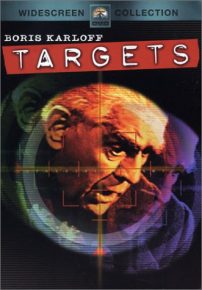 This contrast became even more apparent when I rewatched Targets on the Paramount DVD. Whatever its cinematic virtues, the film has almost as little curiosity about Whitman as it does about his multiple victims; significantly, in his introduction and audio commentary, Bogdanovich twice misremembers Whitman’s own death as a suicide (an error perhaps prompted by all the subsequent mass shootings that ended that way). Another striking contrast between Targets and Tower relates to their notions of what constitutes verisimilitude. Targets is, of course, a fiction film, and one whose relation to “truth” and believability is almost entirely a matter of mise en scène and genre conventions. Tower is a documentary, but one composed of a daring mix of rotoscope-like animation derived from live-action footage (as in Richard Linklater’s 2001 Waking Life) and recent as well as archival live-action footage (including segments with actors playing the characters in 1966 while many of their real-life counterparts recount their memories of the events), often mixing diverse elements from all these materials within the same shots, as if to acknowledge that our grasp of “the truth” is generally dependent on fictional as well as nonfictional materials.
This contrast became even more apparent when I rewatched Targets on the Paramount DVD. Whatever its cinematic virtues, the film has almost as little curiosity about Whitman as it does about his multiple victims; significantly, in his introduction and audio commentary, Bogdanovich twice misremembers Whitman’s own death as a suicide (an error perhaps prompted by all the subsequent mass shootings that ended that way). Another striking contrast between Targets and Tower relates to their notions of what constitutes verisimilitude. Targets is, of course, a fiction film, and one whose relation to “truth” and believability is almost entirely a matter of mise en scène and genre conventions. Tower is a documentary, but one composed of a daring mix of rotoscope-like animation derived from live-action footage (as in Richard Linklater’s 2001 Waking Life) and recent as well as archival live-action footage (including segments with actors playing the characters in 1966 while many of their real-life counterparts recount their memories of the events), often mixing diverse elements from all these materials within the same shots, as if to acknowledge that our grasp of “the truth” is generally dependent on fictional as well as nonfictional materials.


